Studio Visit
In an Adobe Studio Built By Her Uncle, Rose B. Simpson Creates Works to Stay Connected to Her Community
Simpson's newest solo exhibition "Skeena" is now on view at Jessica Silverman in San Francisco.
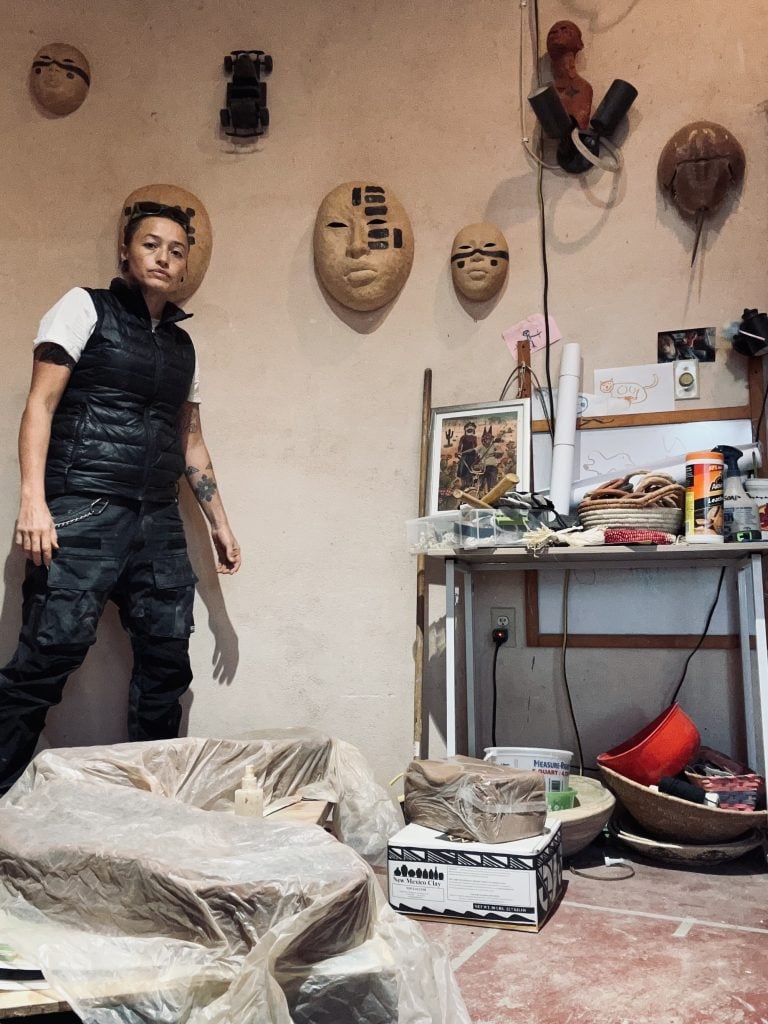
Simpson's newest solo exhibition "Skeena" is now on view at Jessica Silverman in San Francisco.

Katie White

Twelve years ago, the artist Rose B. Simpson moved into a studio built by her great-uncle, the artist Michael Naranjo, at the edges of Santa Clara Pueblo near Española, New Mexico. Made with uniquely rounded walls and attached to a larger adobe home, the studio has been the site of Simpson’s mixed-media experimentations ever since. There she creates the figurative, ceramic sculpture for which she is best known. Meanwhile, in a metalworking shop that she’s attached to the studio, Simpson works with cars and automotive devices. (Española is the lowrider capital of the world.)
This creative space is one that’s deeply rooted in Simpson’s community and family life. Her daughter and her mother—the ceramic artist Roxanne Swentzell—can often be found coming and going from the space.
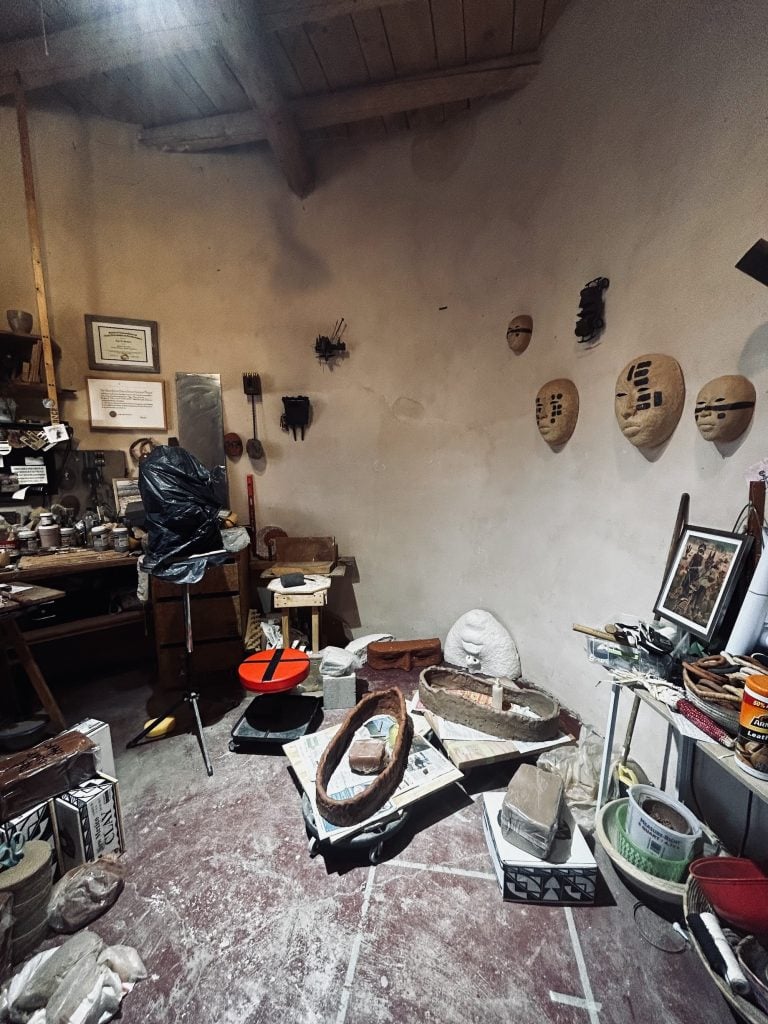
Courtesy of Rose B. Simpson.
In recent months, the artist has been preparing for “Skeena,” a solo show of new sculptures now on view at Jessica Silverman in San Francisco (through December 23, 2023). “Skeena”—Latino slang for the people who have your back—presents 10 large figurative sculptures and one hanging wallwork that explore the artist’s understandings of self, community, and desire, and contemplates the ways we all might become better ancestors.
The exhibition closes out a banner year for the artist. Simpson has had an exhibition at Art@Bainbridge at Princeton University, a residency and exhibition with The Fabric Workshop in Philadelphia, as well as opened her exhibition “Legacies” now on view at the ICA Boston. She additionally installed the large outdoor installation Counterculture with the Trustees of Reservations in Massachusetts, which has reopened at the Whitney Museum.
Recently, we spoke with Simpson about her memories of the studio, and the faith needed to make art she’s proud of.
Tell us about your studio. Where is it, how did you find it, and what kind of space is it?
I am hopefully moving into a new studio space (in the backyard of the one I’m in now) in the next six months, so answering these questions feels like a bittersweet reflection.
For the past 12 years, I have been working in the studio that my great-uncle Michael Naranjo built for himself, in San Pedro; the checker-boarded edge of Santa Clara Pueblo tribal reservation that borders the town of Española, New Mexico. My great-uncle built the big adobe house for his family in the 1980s and built himself a tall round-walled studio on the morning sun side of the house. My uncle was blinded in the Vietnam War and became an incredible artist upon his return. His studio didn’t initially need any light fixtures, so when I moved in, I ran an extension cord up to a track mounted on one of the vigas (the wooden beams in adobe homes) on the ceiling, where I have mounted lights. I turn on the lights from where the extension cord plugs into the wall.
Looking at the shape of the floor, it is clear the room is actually egg-shaped (13 by 18 feet). This is where I have built almost all of my clay sculptures for the past decade. I used to store my kiln in there as well, but now my mom helped me move her big front-loading electric kiln to a space outside under the covered porch. There is a small room tacked to the rear of it where I have fabric and leather and all ten of my sewing machines. I call this cluttered and disorganized space my “Clean Room.” A few years after I started sharing the studio, I walled in the double carport and this is now my car shop and metal fabrication space.
How did you wind up working in this studio space?
After graduating with my MFA from RISD in 2011, I knew I needed to go back home to Santa Clara. My mom’s non-profit, Flowering Tree Permaculture Institute, had purchased the house my uncle built as a project space, farm, and classroom. She needed someone to live at the house and take care of it; to feed livestock, to irrigate the fields. So I took the caretaker job and set up my practice in the adjacent studio. After living in Albuquerque, Santa Fe, and Providence, I needed to be home. I chose to go home to my ancestral lands for good so that I could maintain a healthy relationship with my community.
I lived in San Pedro until six months after I had a home birth in that beautiful adobe compound. I moved with my baby across the river, into the house my great-grandfather built for my great-grandmother Rose, to share a driveway with my mother. So now I commute ten minutes from home to work at my studio. I often see my mom making the same commute as we live and work at the same places. (She works on her clay at home, but runs and manages the farm and permaculture projects at the San Pedro compound.)
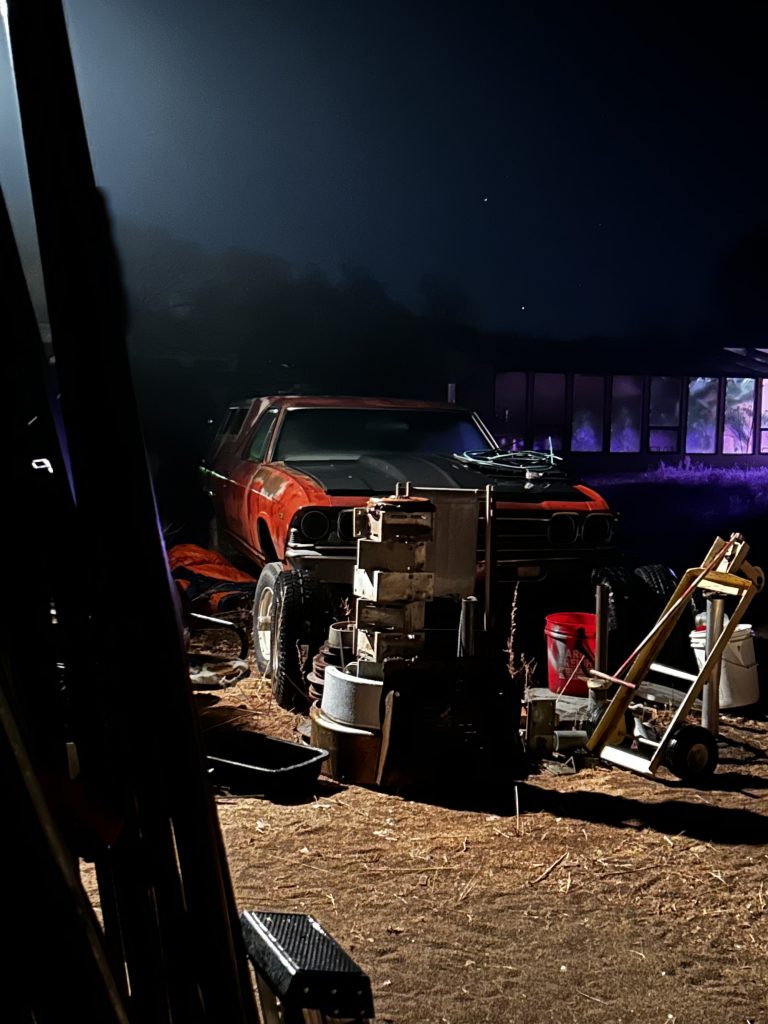
Courtesy of Rose B. Simpson.
Do you have studio assistants or other team members working with you? What do they do?
About a year ago, Dylan, one of my friends from Albuquerque let me know he was doing automotive electrical, and I needed help with some of exactly that. So we started working together on some of my car projects. Since then, I have become so busy that I can’t spend too much time in the car shop, but Dylan can work on some of the projects we have going on.
He is my bro and we spend too much time talking, but I love when he comes into my clay studio to talk about car parts and suspension and transmissions and he ends up sitting on a pile of clay boxes while I push clay around and next thing you know it has been two hours and we have gone through politics, gentrification, religion, cultural dynamics, interpersonal stuff, daddy issues, health, and diet, etc. Sometimes it gets heavy but mostly we crack 12-year-old jokes and laugh hard. He is exceptional and fucking brilliant. Sometimes I trip out because he has become my best friend and I feel so glad to share a space with him. (Except when I am resentful that he gets to work on cars and I can’t, then I’m just mean.)
My mom thinks he’s the best thing that’s happened to us because he fixes her tractor and mower. (That used to be my job. Eyeroll.)
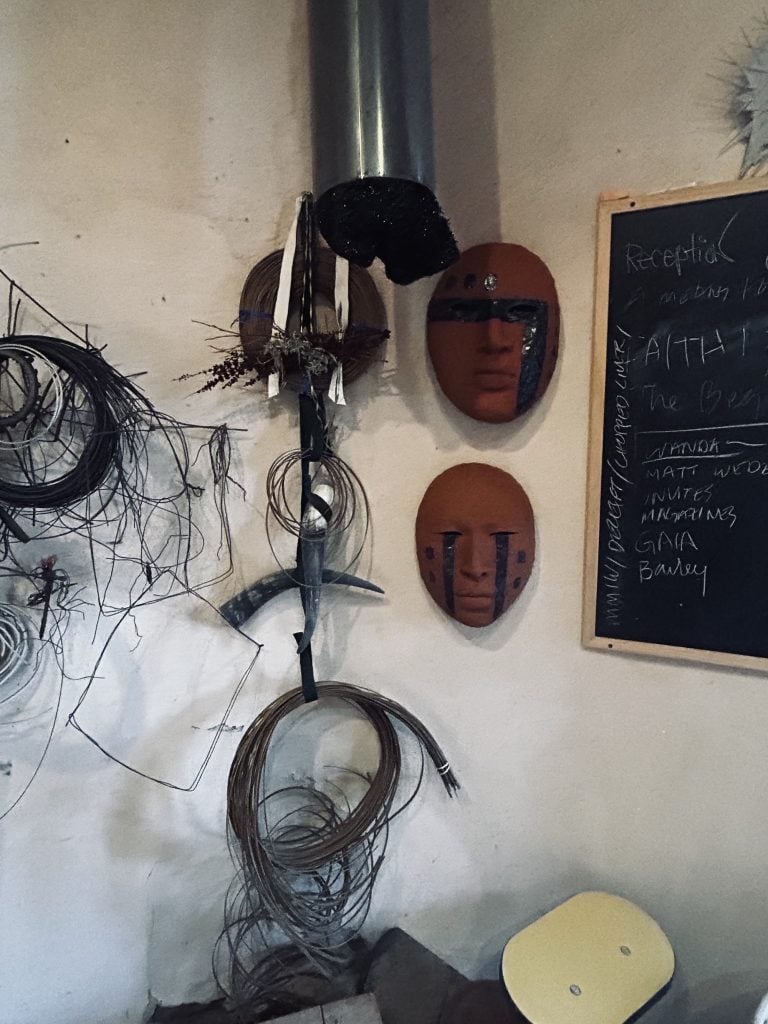
Courtesy of Rose B. Simpson.
How many hours do you typically spend in the studio, what time of day do you feel most productive, and what activities fill the majority of that time?
I usually get to the studio mid-morning, after getting the kid ready for school and doing stuff like laundry, emails, workout/meditation, then I make some tea and work until I have to go meet her at the bus a little after 3 p.m. Sometimes I’m in the middle of something and I have to bring her back to the studio with me after I pick her up to finish what I was doing. I have usually worked for at least four to five hours every day of the week, but I’m trying really hard to take Sundays off. If I can do that, then I can work to take Saturdays off. When I take the kid to the studio with me, she runs to find her cousins or follows my mom off into the fields. Last week, my mom was driving through the front yard with the kid up high in the front bucket of the tractor.
What is a studio task on your agenda this week that you are most looking forward to?
I am getting some of the pivotal pieces of two large public installation pieces complete. I have been worrying about these works because they are heavy— not physically necessarily, but have a lot of weight on them. They need to work out, they need to be what I wanted to see them become, I need to be proud of them. Once they are out the door, some of that pressure will subside. I have been trying to stay in my faith… in a state of allowance and acceptance… because the work will soak in the energy of the environment and respond to it. So I have been practicing staying extra conscious of my state of being so that I don’t negatively affect the work.
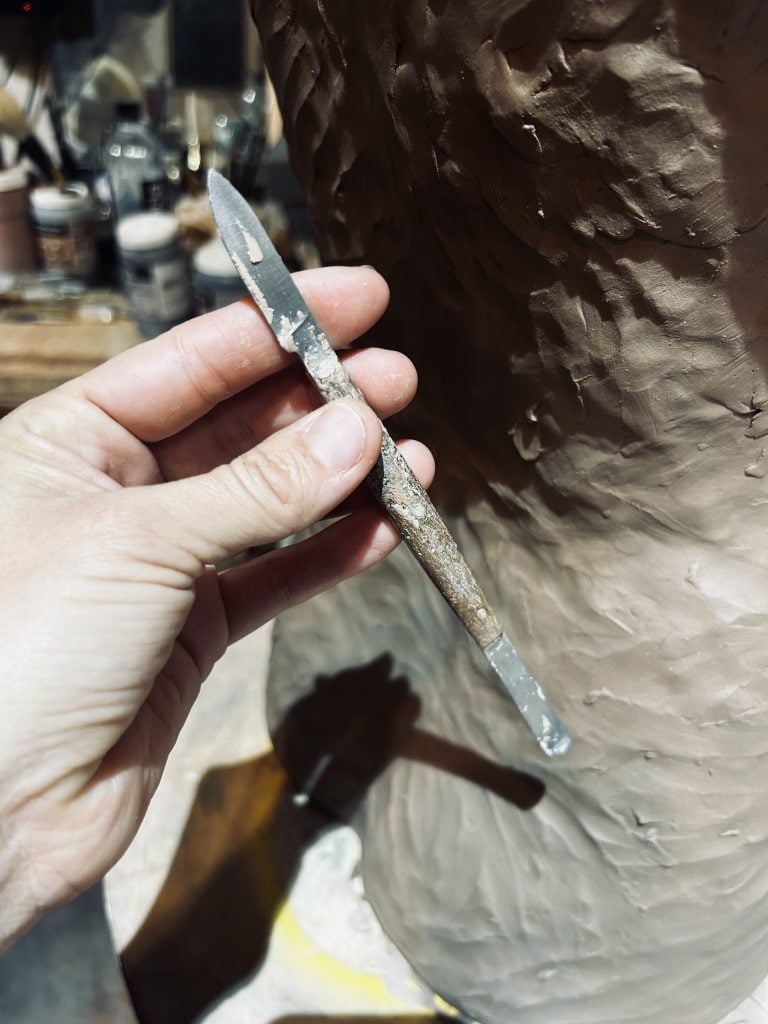
Courtesy of Rose B. Simpson.
What tool or art supply do you enjoy working with the most, and why?
When I was a kid, my mom had a sculpting knife that had turned into something sacred. Someone recognized that and stole it when she was giving a workshop, but remembering it gives me butterflies. I now have my own sacred sculpting knife—something that works perfect, does what I need it to, fits right in my hand, and becomes an energetic tool that is a piece of me.
What kind of atmosphere do you prefer when you work? Is there anything you like to listen to/watch/read/look at etc while in the studio for inspiration or as ambient culture?
I sometimes think that the artists who make the music that I listen to while I work should be credited as collaborators. I have a nice sound system in my studio and I like to swim in the sound. Through the years I have cycled through different types of music that feel right to me. I like reggae a lot because sometimes the music feels like it’s in prayer—which matches the feeling I get when I work and then I can dance. I really love Reemah and my friend Dre Z Melodi, along with the classics. I have a soundtrack called “my shit” on Spotify with like 300 songs that include feelings like Badu, Teyana Taylor, Tierra Whack, Tank and The Bangas, Seinabo Sey, Brother Ali, Jamila Woods, Mereba… Nas, Wu Tang, and my niece Ailani.
If it’s a good day and I get lucky enough to have an internet connection in my studio, I’ll listen to a Matias de Stefano or Zach Bush podcast or have a Gaia show running in the background.
What images or objects do you look at while you work? Do you have any other artist’s work in your studio?
I have an Eliza Naranjo-Morse paper and mixed-media sculpture hanging in my studio next to a Doug Sink piece I love, next to a Mark Herndon piece that I cherish. Eliza is my cousin and my neighbor and I love her and I love her work and she inspires me to be true to myself. The Doug Sink is a wall sculpture that depicts a sort of post-apocalyptic island and I love it… his aesthetic is delicious to me. Mark Herndon was one of my favorite teachers and an incredible artist and craftsman. His piece is a wood house with a tiny diorama inside the crafted window, with a small boulder hung by a hand-made chain from the floor.
These three pieces have hung around for years, and I look forward to living with them forever.
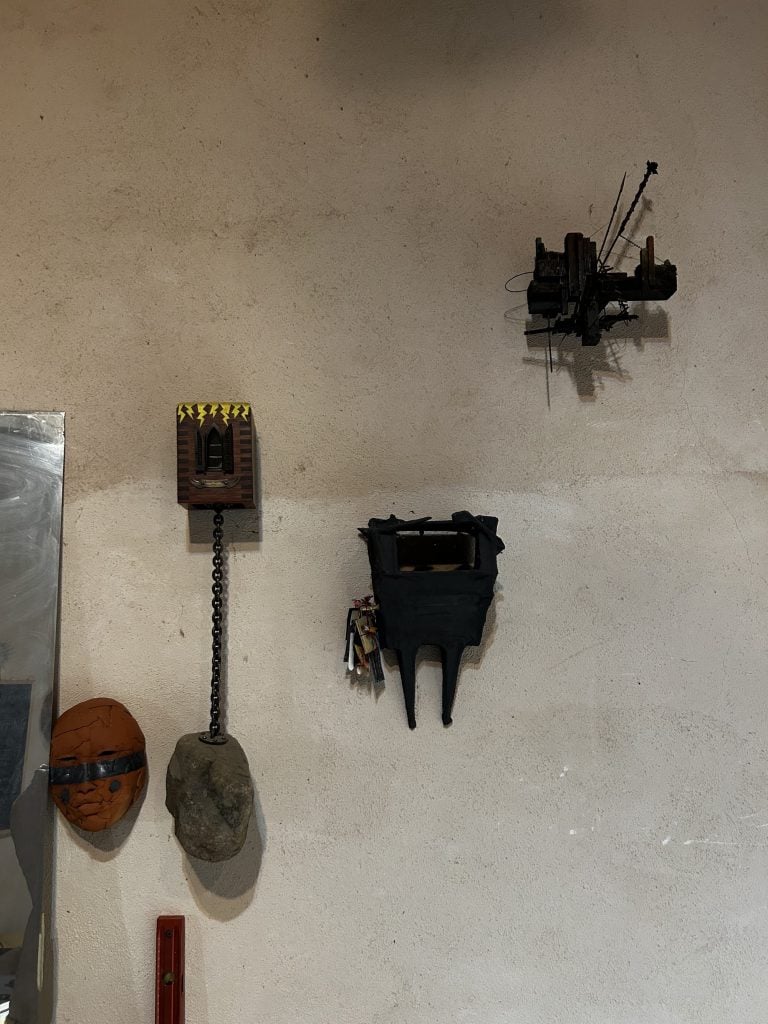
Courtesy of Rose B. Simpson.
Where do you get your food from, or what do you eat when you get hungry at the studio?
My mom sometimes has a work crew or interns or is preparing some pre-contact diet thing or processing something from the fields and she’ll call me to eat. Sometimes I like to splurge on a loaded salad from a place called Blue Zone, a vegan spot that is a three-minute drive from the studio—a big step up from my old Sonic hotdog habit. Sonic is like two blocks away. Other than that I will make a sandwich or a salad from stuff from the greenhouse or I’ll bring some jerky. On a hot summer day, a Sonic unsweetened iced tea float really hits the spot, though. When you come through, we’ll cruise over in one of my rides and I’ll get you one.
Describe the space in three adjectives.
Familial. Real. Beloved.
More Trending Stories:
How an Exclusive NYC Cult Influenced the 1970’s Art Scene
A Rare Soulages Lithograph Possibly Worth $30,000 Sells For $130 in Facebook Marketplace Mishap
Masterpiece or Hot Mess? Here Are 7 Bad Paintings by Famous Artists
Is There a Hat Better Than Napoleon’s? We Rank Art History’s 5 Most Iconic Chapeaux